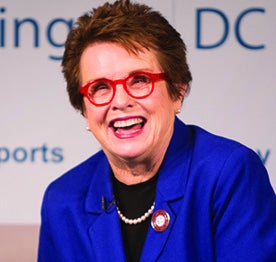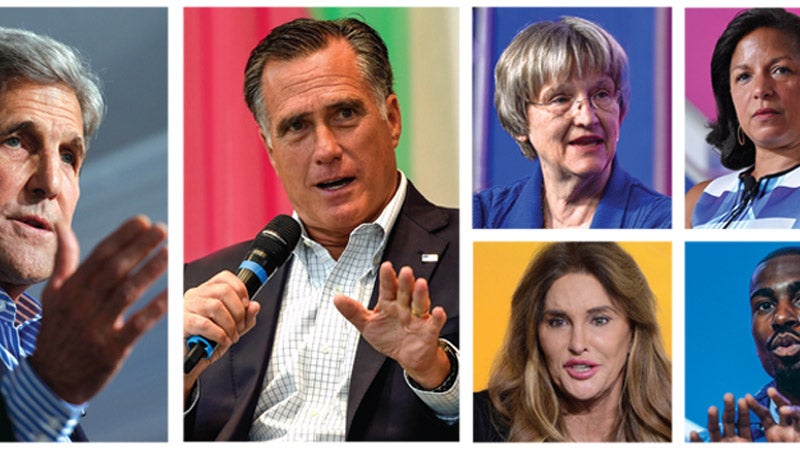Picture an idyllic American summer. Does it include evenings playing tag with friends in the front yard until the fireflies come out? Or maybe long, hot afternoons at the basketball court with kids from the neighborhood?
 That isn’t the state of summer—or the state of play—in America anymore, said First Lady Michelle Obama at the 2016 Project Play Summit in May, hosted by the Institute’s Sports & Society Program as part of their Project Play initiative. “Either you can’t play outside because it’s unsafe, or you’re the only kid playing outside because everybody else is overspecialized,” she said. “[Kids] don’t even have the concept of play.”
That isn’t the state of summer—or the state of play—in America anymore, said First Lady Michelle Obama at the 2016 Project Play Summit in May, hosted by the Institute’s Sports & Society Program as part of their Project Play initiative. “Either you can’t play outside because it’s unsafe, or you’re the only kid playing outside because everybody else is overspecialized,” she said. “[Kids] don’t even have the concept of play.”
During her featured session at the Summit, Obama; her brother, Craig Robinson, of ESPN, and his colleague Michael Wilbon reflected on their childhoods on Chicago’s South Side and on the importance of making sports affordable and accessible to youth across the United States. Obama called for quality athletic opportunities for every child, regardless of zip code or family income. “How much are we willing to invest in the kids in our society?” she asked. “So many communities are becoming play deserts, but in wealthy communities, there is a wealth of resources … The disparities are amazing to me. Are we saying that some kids are worthy of investment, and then there are millions of others who aren’t?”
Launched in 2013, Project Play is reimagining US sports culture by putting health and inclusion at the core of its values. The initiative gathers leaders from across eight sectors that touch the lives of children—community recreation groups, national sport organizations, policymakers and civic leaders, education, parents, public health, business and industry, and tech and media.
 At the Summit, some of the featured leaders included top figures like Mary Davis, the CEO of the Special Olympics International; Tab Ramos, the youth technical director of the US Soccer Federation; Bennet Omalu, the chief medical examiner for San Joaquin County, California; Risa Lavizzo-Mourey, the president and CEO of the Robert Wood Johnson Foundation; and Billie Jean King, the founder of the Women’s Sports Foundation. All Summit speakers talked about the current shape of sports and play in the United States, from activities for people with disabilities to mitigating the risk of concussions in high-impact sports.
At the Summit, some of the featured leaders included top figures like Mary Davis, the CEO of the Special Olympics International; Tab Ramos, the youth technical director of the US Soccer Federation; Bennet Omalu, the chief medical examiner for San Joaquin County, California; Risa Lavizzo-Mourey, the president and CEO of the Robert Wood Johnson Foundation; and Billie Jean King, the founder of the Women’s Sports Foundation. All Summit speakers talked about the current shape of sports and play in the United States, from activities for people with disabilities to mitigating the risk of concussions in high-impact sports.
The Project Play Summit sessions also informed the Sports & Society Program’s newest report, “State of Play: 2016,” which came out in June. The report provides an annual snapshot of the creative ways different groups are serving children and communities through sports. In addition to incorporating insights from Summit speakers, the report examined data from the crowd by using Microsoft Pulse’s instant-polling software to ask them about sports today.
“State of Play: 2016” looked at national data, too. According to the report, the percentage of youth who are physically active through sports fell, even though sports participation among six- to 12-year-olds rose slightly. Federal support for recreation infrastructure grew, but gaps in access to sports in low-income areas became more pronounced. Major sports organizations are also beginning to promote the idea that kids should diversify their activities and play more than one sport, but the number of team sports the average child played fell. And in 2015, only 25 percent of youth sports coaches were women.
There has been no growth in the percentage of women’s coaches in recent years.
That’s something Billie Jean King wants addressed. She encouraged the audience to remember women when thinking about sports accessibility. “We don’t have enough women coaches,” she said. “Don’t forget about the girls and the women: we are half of the population.” King also stressed the ways that sports make communities safer—such as by keeping restless kids occupied with something good for them, an issue that is addressed in “State of Play: 2016.”
“We’re excited to offer this report to a wide variety of constituencies, from parents to policymakers to sports leaders who have an interest in getting kids off the couch without running them into the ground,” said Tom Farrey, executive director of the Sports & Society Program. “It’s one-stop shopping for understanding the landscape of youth sport today.”


